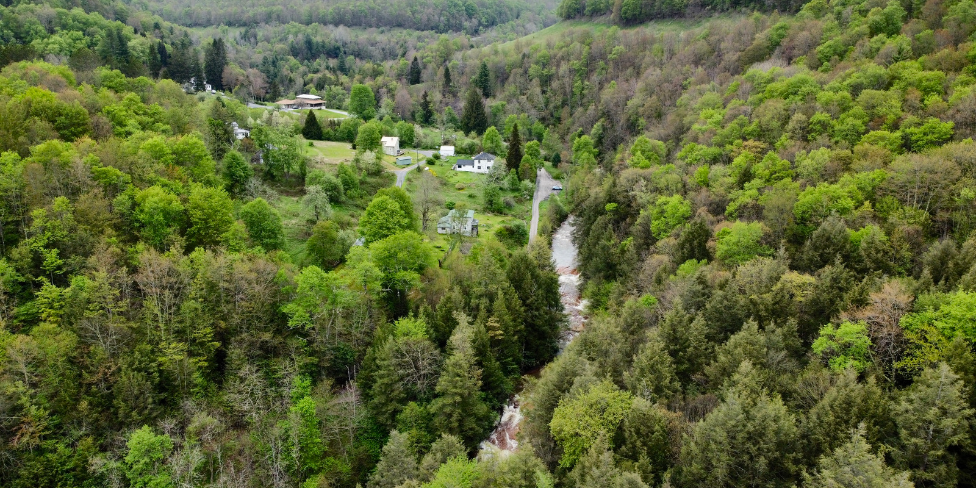By Hugh Rogers
First, the West Virginia Northern Flying Squirrel graduated from the endangered species list.
In a Settlement Agreement signed in 2000 by the Federal Highway Administration, the West Virginia Division of Highways, and fifteen environmental groups, the Division of Highways committed to “evaluate one or more alignment shifts for the Thomas-Davis Section” of the Parsons to Davis Project. The alignments would avoid a National Register-eligible historic site, the Blackwater Industrial Complex. They were called Blackwater Avoidance Alignments.
The study area made a semicircle north of Thomas, from just outside Davis on the east to Benbush, less than two miles west. From there, it extended southwest three miles to meet the preferred alignment. Its southern boundary followed that alignment except for an irregular cutout for the historic district.
In preparation for a Supplemental Draft Environmental Impact Statement (SDEIS), live traps were set to determine the presence of the then-endangered flying squirrel. Squirrels were captured both within and outside the study area. The Fish and Wildlife Service recommended expansion of the study area to the north and west. The new area’s western boundary was more than twice as long.
By August 2002, the Blackwater Avoidance Alignments had been reconfigured into the Squirrel Avoidance Alternatives, SAA 1 and SAA 2. The combination accomplished its purpose: a biological assessment concluded that while the Division of Highway’s preferred alignment would adversely affect the squirrel, the alternatives would not.
Then the rules changed. All possible habitats were assumed to be occupied—so the alternatives had no advantage. Moreover, it was discovered that the expanded study area contained highly suitable habitat, which the original area did not. And it had other problems: directing the highway beyond the edge of Backbone Mountain would require extra-large cuts and excess waste. Some of this would inevitably be dumped into trout streams. Although the alternatives continued to be less damaging by most measures, such as impacts to wetlands, flood plains, and stream relocations, their additional length and difficult topography made them more expensive.
Thus, 20 some years ago, a single issue hijacked the alignment selection process. That’s no longer the case. The flying squirrel’s success, marked by a 2013 de-listing, requires consideration of fresh alternatives in a new Environmental Impact Statement. It’s time for the Divisions of Highway to complete its original assignment.
Second, in Davis and Thomas, the economy has turned around.
Quoting the most recent (2007) Environmental Impact Statement for the Parsons to Davis Project (p. III-2):
“The 1996 Corridor H Final Environmental Impact Statement provided a description of the existing economic environment in Tucker County. Updated census data available confirms that some population and economic trends have not changed since the approval of [that document] in 1996.”
In Thomas and Davis specifically, the population declined roughly 20% between 1980 and 1990 and continued that trend between 1990 and 2000. Within the study area, including the towns, the poverty rate was 16%.
Until recently, the Division of Highways would have been justified in relying on 30 or 40-year-old population and economic data. The news was negative, and the story never changed. It was the story that brought us the Appalachian Development Highway System, a one size fits all cure.
In our case, a highway made a difference by stopping at the right place. The Corridor’s arrival from the east in 2015 accelerated a local turnaround.
Here are some of the changes: after decades of population losses, Thomas began to gain. From 2000 to 2021, it grew faster than 74% of cities its size, not just in West Virginia or Appalachia but in the entire country. Small towns have been slowly dying everywhere, so a small gain—or, in Davis’s case, holding steady—is significant.
The Secretary of State’s Business Statistics database shows new businesses opened, year by year: in 2014, 44; 2018, 62; 2020, 91. Most recently, in the year since July 2022, 106 have opened. The five-year growth rate is 102%. These are figures for Tucker County, not the study area, but the latter has been the most active. We know that for Thomas and Davis combined, the number of new businesses more than doubled between 2015 and 2021.
In its recent report, “Bracing for Change,” Downstream Strategies confirmed that “Together, these two communities have gained notice among the most desirable small towns in America.”
This “significant change in circumstances,” to use the language of the National Environmental Policy Act, requires an alignment compatible with a thriving tourist economy. Corridor H has had an undeniable influence, but its benefits are largely due to the fact that it stopped at Davis. It brings in visitors without damaging what attracted them. From there, it should take through traffic around Thomas—giving that town its own exit—preserving the Blackwater area as West Virginia’s “crown jewel,” in the words of the late Senator Robert Byrd.

